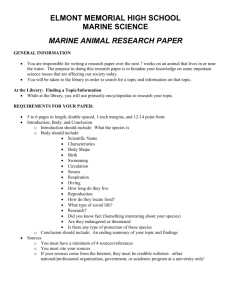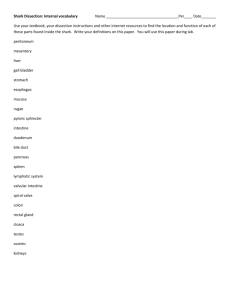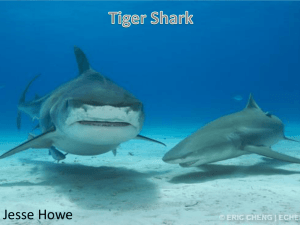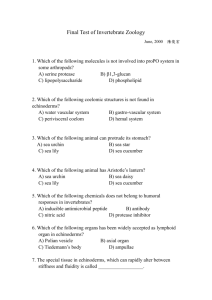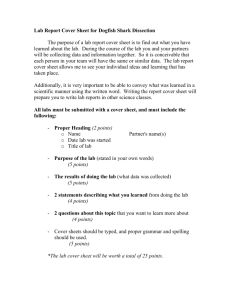What does Echinodermata mean? How old are Echinoderms
advertisement
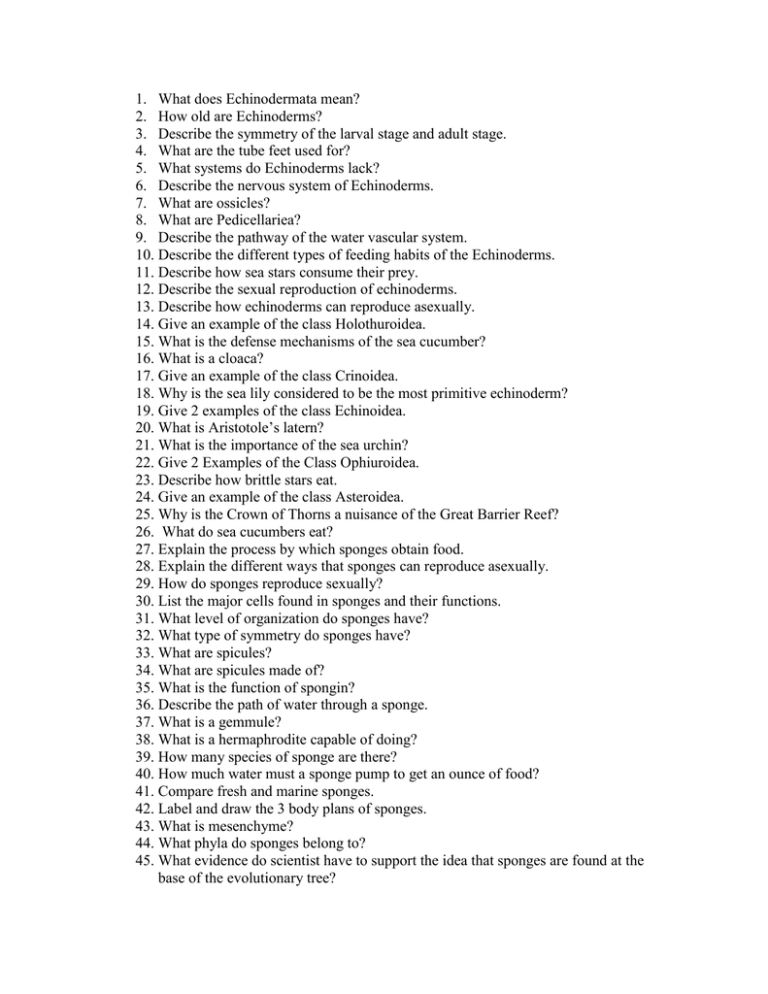
1. What does Echinodermata mean? 2. How old are Echinoderms? 3. Describe the symmetry of the larval stage and adult stage. 4. What are the tube feet used for? 5. What systems do Echinoderms lack? 6. Describe the nervous system of Echinoderms. 7. What are ossicles? 8. What are Pedicellariea? 9. Describe the pathway of the water vascular system. 10. Describe the different types of feeding habits of the Echinoderms. 11. Describe how sea stars consume their prey. 12. Describe the sexual reproduction of echinoderms. 13. Describe how echinoderms can reproduce asexually. 14. Give an example of the class Holothuroidea. 15. What is the defense mechanisms of the sea cucumber? 16. What is a cloaca? 17. Give an example of the class Crinoidea. 18. Why is the sea lily considered to be the most primitive echinoderm? 19. Give 2 examples of the class Echinoidea. 20. What is Aristotole’s latern? 21. What is the importance of the sea urchin? 22. Give 2 Examples of the Class Ophiuroidea. 23. Describe how brittle stars eat. 24. Give an example of the class Asteroidea. 25. Why is the Crown of Thorns a nuisance of the Great Barrier Reef? 26. What do sea cucumbers eat? 27. Explain the process by which sponges obtain food. 28. Explain the different ways that sponges can reproduce asexually. 29. How do sponges reproduce sexually? 30. List the major cells found in sponges and their functions. 31. What level of organization do sponges have? 32. What type of symmetry do sponges have? 33. What are spicules? 34. What are spicules made of? 35. What is the function of spongin? 36. Describe the path of water through a sponge. 37. What is a gemmule? 38. What is a hermaphrodite capable of doing? 39. How many species of sponge are there? 40. How much water must a sponge pump to get an ounce of food? 41. Compare fresh and marine sponges. 42. Label and draw the 3 body plans of sponges. 43. What is mesenchyme? 44. What phyla do sponges belong to? 45. What evidence do scientist have to support the idea that sponges are found at the base of the evolutionary tree? 46. What is a nematocyst? 47. What are cnidocytes? 48. Where does digestion take place in cnidarians? 49. What is an example of a hydrozoan colony? 50. What is the difference between a polyp and a medusa? 51. What body form is a jellyfish? a sea anemone? and a Portuguese man of war? 52. How are coral reefs formed? 53. List each class of Cnidarians and give an example of each. 54. What is another name for comb jellies? 55. How many spps of cnidarians are there? Ctenophore? 56. What class of cnidarians has the most dangerous venom? 57. What do cnidarians contain that makes them more complex than sponges? 58. What is a ephyra? 59. Explain how jellyfish exhibit alternation of generations. 60. How many tissue layers do cnidarians have? 61. How do ctenophores move? 62. What group would you find the longest animal in the world? 63. Compare how cnidarians and ctenophores eat. 64. What are 3 things that killed coral reefs? 65. What is the gel-like material found in cnidarians called? 66. What type of coral builds reefs? 67. Describe the body shape of most sharks and explain how it makes it well suited for their environment. 68. Describe how countershading makes sharks well suited for their environments. 69. Draw and label the typical fin types of a shark. 70. Describe the function of each of the fins listed above. 71. Describe the skeleton of a shark. 72. What is a denticle? 73. How do denticles aid in the swimming ability of a shark? 74. Describe the structure of the shark heart. 75. Describe the pathway of blood flow in a shark. 76. Distinguish between the two type of muscles found in sharks. 77. What are some benefits to being an ectotherm? 78. Describe 6 ways that a sharks body plan is energy efficient. 79. Describe a shark’s sense of smell. 80. What is the function of the lateral line? 81. Describe Ampullae of Lorenzini and their function. 82. What are claspers? 83. What is the largest shark? 84. What is the fastest shark? 85. What shark can weigh up to 5000 pounds? 86. What shark is responsible for most near shore attacks? 87. What shark is a night time hunter? 88. What shark is known for making spinning leaps out of the water? 89. Describe the diet of a shark/ 90. What four sharks are accountable for most shark attacks? 91. How can you reduce your chance of being attacked? 92. What has led to the decrease of many spps of shark? 93. Why do we need shark conservation? 94. What is the difference between a ray and a skate? 95. Distinguish between a hagfish and a lamprey. 96. What class do they belong? 97. What class do bony fish belong? 98. How many spps of Marine fish are there? 99. What is the operculum? 100. What is the difference between a ray and a spin? 101. Label the fins of a bony fish. 102. What is the function of each fin? 103. Describe a scale. 104. How can you age a fish by looking at its scale? 105. Describe the gills of a bony fish. 106. What is the function of the gills? 107. Describe how most bony fish use their swim bladder to regulate buoyancy? 108. What is the lateral line? 109. What is the function of the lateral line? 110. Describe the possible body plans of a bony fish. 111. What is the difference in coloration of an open ocean in comparison with a reef fish? 112. Describe the reproduction strategy of most bony fish. 113. What is the difference between a hermaphrodite and a sequential hermaphrodite? 114. What is the difference between roe and caviar? 115. Compare the Polar Ecosystems with Coral Reef Ecosystems in terms of population size and diversity. 116. What are the challengers of life in the Artic? 117. Explain how the waters of the poles becomes nutrient rich during the summer months. 118. Is the Arctic a frozen sea or a continent? 119. Is the Antarctic a frozen sea of a continent? 120. How big does the Antarctic get during the winter? 121. What class and order do penguins belong? 122. How many spps of Penguins? 123. Where are penguins located? 124. What adaptations do penguins have to cope with marine life? 125. What is the only penguin to stay on the Antarctic year round? 126. What do penguins eat? 127. Compare the largest and smallest penguin in terms of weight and height. 128. How many penguins live on the Antarctic? 129. List the penguins found on the Antarctic and their scientific names. 130. Which penguin does not build a nest lined with stones? 131. Which is the fastest penguin? 132. List 4 characteristics that most mammals have. 133. Why must marine mammals breath air? 134. Describe 2 adaptations they have for holding their breath for long periods of time. 135. How do marine mammals deal with water pressure and the need to equalize? 136. How do dolphins and whales communicate? 137. How do dolphins and whales locate prey? 138. What order do whales and dolphins belong? 139. What is blubber? 140. What suborder contains baleen whales? 141. Describe baleen and what it is used for. 142. List the whales that are filter feeders and their scientific names. 143. Describe the migration pattern of most whales. 144. Which whale is normally covered with parasites. 145. What is the largest whale? 146. Describe a blue whale calf. 147. What order do the toothed whales belong? 148. List the toothed whales and their scientific names. 149. Which whale has the largest brain? 150. What is spermaceti and what is it used for? 151. Which whale has a tusk? 152. Which whale is also called the white whale? 153. Describe the stages of a whale fall. 154.

